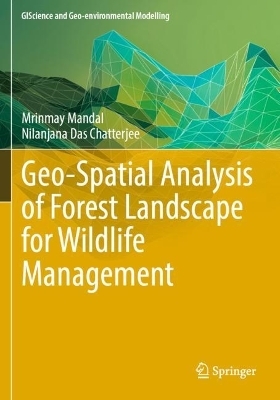
Geo-Spatial Analysis of Forest Landscape for Wildlife Management
Springer International Publishing (Verlag)
978-3-031-33608-9 (ISBN)
This book presents research on landscape ecology and the relationship between humans and wildlife. It helps readers understand how ecological patterns and processes are interconnected. This research illustrates and proposes (practicable) management strategies toward long-term ecological restoration and mitigation of consequences of conflict.
Increasing wildlife activities in localities and forest fringes are an alarming issue. Ecological processes like movement, colonization, extinction and conflict issues depend on the landscape and ecological activities, the movement for example of migratory elephants and their colonization not only affects society but the wildlife and biodiversity too. Strategic management measures can contribute to enriching the biodiversity, habitat quality as well as landscape, while minimizing human-wildlife conflicts. This book describes landscape ecological patterns and processes, habitat dominancy, habitat dependency, suitability, connectivity andcorridor selection. To synthesize these patterns and processes, several ecological indices are used. Use of geo-spatial techniques improves future management strategies for similar circumstances, especially, related to forest regeneration and forest restoration.
This book provides a concise overview to a wide range of readers including postgraduate students, researcher, academics, landscape planners, decision makers and even local populations. The techniques and management strategies described should help planners to improve forest management, by implementing quality enhancement programs such as plantation area selection and corridor selection.
Dr. Mrinmay Mandal is currently working as an assistant teacher at Shyamsundarpur Jr. High School, Paschim Medinipur in West Bengal. He obtained his M.Sc (2010) from Department of Geography, Vidyasagar University in India. He received his PhD award from the same department in 2019. He has 10 years experience in research in this subject. His major area of research interests are Landscape Ecology, Habitat Management, Wildlife Behavior Assessment, Human-Elephant Conflict and its Social Perspective. Maximum field experience involved in forest composition analysis, wildlife corridor identification, elephant habitat use and selection, understanding Human-Elephant Conflict characters He has specially trained in remote sensing and GIS. More than 6 research articles have been published in leading international SCI journals. Recently, more than five articles are under review for publication in international SCI journals.
Dr. Nilanjana Das Chatterjee is Professor and former HOD in the Department of Geography, Vidyasagar University, West Bengal, India. She received her Ph.D. award from Burdwan University in 2009. She is an expert in the field of Bio-geography with special reference to human-elephant conflict in forest fringes and fragmented forest, Environment, Landscape ecology with special reference to urban ecology, Tribal Culture and Women's studies. She has nearly 25 years of experience in research and teaching, and has authored more than 80 national and international research articles with high impact factor journals and received many prestigious awards. She is one of the twenty women scientists recognized by the Wildlife Institute of India, Dehradun. She is an enthusiastic IUCN Commission member of CEM. Seven research scholars achieved their Ph.D. award and twelve students completed their M Phil degree under her supervision. She has completed a major project funded by ICSSR, New Delhi. Now she has completed a research programme funded by ICSSR on "Crime against Women West Bengal". She has authored the book "Man Elephant Conflict: A case study from forests in West Bengal, India" published from Springer in 2016 and co-author of the book River Sand Mining Modelling and Sustainable Practice:The Kangsabati River, India, published from Springer Environmental Science and Engineering Series in 2021.Recently she has published another book on GIS Application for crime prediction: A spatio-temporal analysis for crime against women in West Bengal, India. Being a devoted teacher her passion is to maintain a good student teacher relationship.
1. Landscape Background Study Area and Wildlife History.- 2. Conceptual Framework of Landscape Spatial Character and Ecological Interaction.- 3. Quantification of Forest Landscape Pattern for Habitat Quality Assessment.- 4. Quality Assessments Through Analysis of Forest Habitat Configuration and Composition.- 5. Assessment of Habitat Structural Connectivity and Corridors from Ecological Point of View.- 6. Species Specific Habitat Quality Assessment- Asian Elephant (Elephas Maximus).- 7. Effective Landscape Management Methods to Improve Ecological Quality of Forest Habitat: Case Studies in the Fragmented Habitats.- 8. Landscape Management Methods to Enhance Habitat Quality for Wild Life Conservation in General And Elephants in Specific.
| Erscheinungsdatum | 07.11.2024 |
|---|---|
| Reihe/Serie | GIScience and Geo-environmental Modelling |
| Zusatzinfo | XXIX, 170 p. 130 illus., 123 illus. in color. |
| Verlagsort | Cham |
| Sprache | englisch |
| Maße | 178 x 254 mm |
| Themenwelt | Naturwissenschaften ► Biologie ► Ökologie / Naturschutz |
| Schlagworte | Biodiversity Issue • forest fragmentation • Forest Patch Structure • Habitat Composition • Habitat Corridor Development • Habitat Interaction • landscape ecology • Landscape Matrix Model • Spatial Alteration Model • Wildlife Conflict |
| ISBN-10 | 3-031-33608-9 / 3031336089 |
| ISBN-13 | 978-3-031-33608-9 / 9783031336089 |
| Zustand | Neuware |
| Informationen gemäß Produktsicherheitsverordnung (GPSR) | |
| Haben Sie eine Frage zum Produkt? |
aus dem Bereich


